MyPortugalHoliday.com
The best independent guide to Central Portugal
MyPortugalHoliday.com
The best independent guide to Central Portugal
Day trip to Tomar and 1 day walking tour for 2025
Tomar stands as one of central Portugal's most captivating historic towns, where the legacy of the Knights Templar lives on through magnificent monuments and medieval streets.
This charming town along the Nabão River was once the religious headquarters of the Templars, and later the Order of Christ - the secretive order that would go on to finance Portugal's Age of Discovery.
Unlike the busier tourist destinations, Tomar maintains an authentic Portuguese atmosphere with its traditional cafés, cobbled streets and relaxed pace of life. The town offers enough historical sights to fill a rewarding day of exploration, from the remarkable Templar castle to Gothic churches.
This guide provides everything you need for a perfect day trip to Tomar, including practical travel information, walking routes and insider tips to help you make the most of your visit to this fascinating Templar town.
Highlights of a day trip to Tomar
Convento de Cristo - A vast monastery-fortress complex showcasing eight centuries of Portuguese architecture. The highlight is the extraordinary Charola, a 16-sided Templar chapel where knights could attend mass on horseback, adorned with stunning 16th-century artworks.
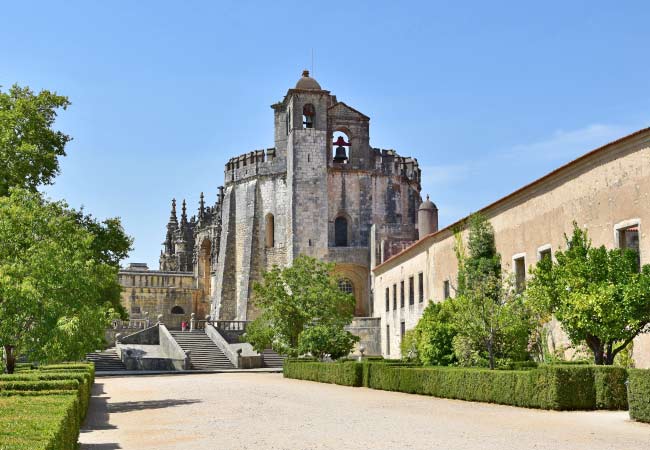
Castelo de Tomar - The imposing 12th-century castle built by the Templars to defend central Portugal. Walk the restored battlements for panoramic views across the town and surrounding countryside.
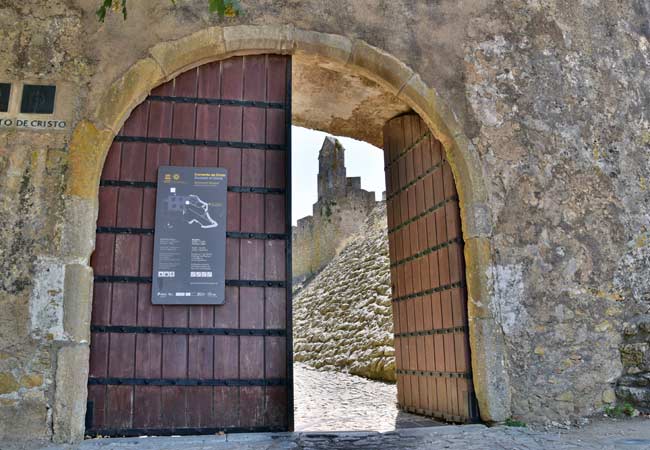
Historic centre - Wander through atmospheric medieval streets lined with traditional houses, discovering hidden squares and the picturesque Praça da República with its statue of Templar founder Gualdim Pais.
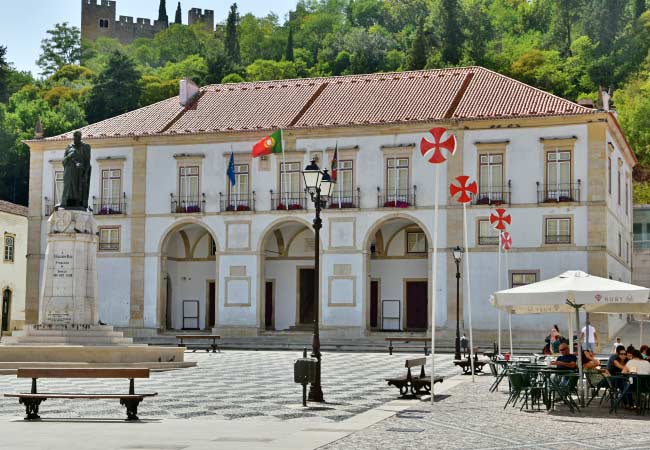
Pegões Aqueduct - A monumental 16th-century aqueduct built to supply the Convento de Cristo. Walk along a section of this 6km-long engineering marvel for unforgettable views and a true sense of its scale.
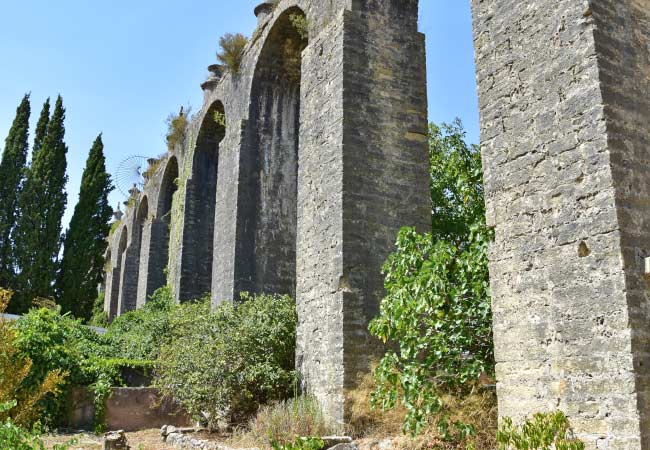
Suggested 1 day walking tour of Tomar
This walking tour covers all the major attractions of Tomar in a logical route that allows you to experience the town's rich Templar heritage, medieval architecture, and authentic Portuguese atmosphere. The entire walk takes about 4-5 hours (7km) at a relaxed pace, including time to properly explore each sight.
The interactive map below marks the suggested route through Tomar's historic centre. The tour begins from the train station, which is where most visitors arrive, though those arriving by car can start from the Várzea Grande car park nearby.
Sights of the walking tour: 1) Train Station 2) Parque do Mouchão 3) Ponte Velha 4) Rua Serpa Pinto 5) Sinagoga de Tomar 6) Praça da República 7) b 8) Câmara Municipal de Tomar 9) Castelo de Tomar 10) Convento de Cristo (entrance) 11) Charola 12) Nossa Senhora da Conceição 13) Mata Nacional dos Sete Montes 14) Igreja de Santa Maria dos Olivais 15) Museu dos Fósforos 16) Igreja de São Francisco 17) Pegões Aqueduct 18) Castelo de Almourol
Note: The full tour is detailed later in this guide
Opening Hours & Entry Fees
Convento de Cristo: €15 for adults, €7.50 for young people (ages 13-24), and free for children under 12. Open daily 9:00-17:00
Where to Go for Lunch in Tomar
Tomar's restaurants offer authentic Portuguese cuisine at prices well below the coastal tourist areas. The town excels at traditional Ribatejo dishes, with generous portions of meat and river fish. Here are five excellent, real options for your midday meal.
1. O Tabuleiro - Price: €€ (Mains approx. €12-€18)
A local institution just off the main square, Praça da República. This is the place for hearty, no-nonsense traditional food served in a bustling, friendly atmosphere. Their half portions (meia dose) are famously generous and often enough for one person. It's a true taste of the region.
2. A Brasinha - Price: € (Full meal often under €15)
For a quick, delicious, and unbeatable value lunch, you can't go wrong with a classic Portuguese churrasqueira. A Brasinha is a popular local choice for perfectly grilled chicken (frango assado) and fish, served with chips, rice, and salad. It's simple, fast, and always satisfying.
3. Restaurante Bela Vista - Price: €€€ (Mains approx. €18-€25)
If you want your lunch to come with a view, this is the spot. As the name ("Beautiful View") suggests, its terrace offers a wonderful panorama of the Nabão River with the castle perched above. The food is traditional Portuguese, well-prepared and presented. It's ideal for a more leisurely and scenic lunch.
4. Cervejaria do Fernando - Price: €€ (Mains approx. €15-€25)
If you're a fan of fresh seafood, head to this lively cervejaria (beer hall/seafood restaurant). It's a casual spot popular with locals for its excellent shellfish (marisco), fresh fish, and classic dishes such as pica-pau (marinated meat bites). The atmosphere is loud, fun, and quintessentially Portuguese.
5. Taverna Antiqua - Price: €€€ (Mains approx. €25-€35)
While often seen as a dinner destination, this medieval-themed tavern can be an unforgettable lunch experience if you have the time. You'll dine by candlelight on historical recipes served by staff in period costume. It transports you back to the time of the Templars. Booking is highly recommended, even for lunch.
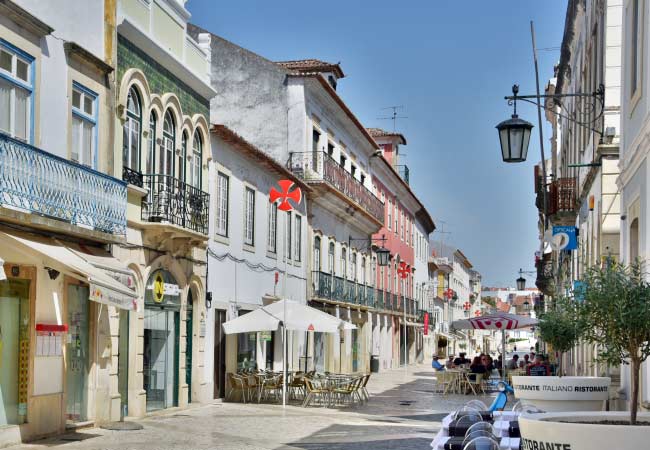
Travel to Tomar for a Day Trip
Getting to Tomar from Lisbon is straightforward, though the town's limited public transport connections mean some planning is required.
By Train
The train is the most convenient option for a day trip from Lisbon. Direct regional trains depart regularly from Santa Apolónia and Oriente station in Lisbon, with the journey taking two hours. A single ticket costs around €11.05, while a return offers better value at €19.90. Tomar is the final stop on the line, and its station is located about 800m south of the historic centre, an easy eight-minute walk to the main square. For the latest timetables and to purchase tickets, it is always best to visit the official Comboios de Portugal website at www.cp.pt.
Insight: When searching for tickets, you may also see more expensive express train services. Be aware that these require a connection at Entroncamento; when the connection time is factored in, these services are often no faster than the direct regional train but are more expensive. For this reason, the direct regional service is the better option for a day trip.
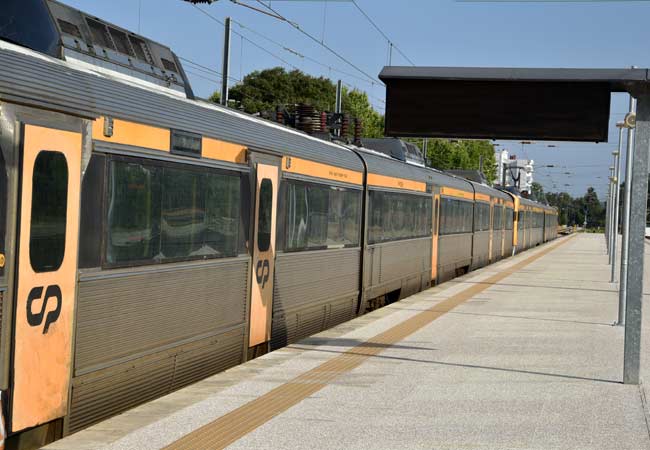
By Car
Driving offers more flexibility for exploring the surrounding region. The 135km journey from Lisbon takes about 90 minutes via the A1 motorway. To reach the town, take the A1 north from Lisbon, exit at junction 6, and then follow the N110 directly to Tomar. Ample free parking is usually available at the large Várzea Grande square (GPS 39.599, -8.413) near the train station, though there is also limited paid parking available closer to the Convento de Cristo entrance (GPS: 39.604, -8.417).
By Bus
While possible, bus connections are less convenient than the train. Rede Expressos operates services from Lisbon's Sete Rios terminal, but journey times can exceed 2.5 hours and often require connections, making it a slower option for a day trip.
Tomar Compared to Other Central Portugal Day Trips
When planning day trips in central Portugal, each town offers different attractions:
Tomar vs Óbidos: Óbidos is one of Portugal's prettiest towns, but it is relatively small and sadly always crowded with tours and day trippers. Tomar is almost as pretty and offers a much more authentic Portuguese experience.
Tomar vs Batalha: The Mosteiro da Batalha is architecturally stunning, but beyond the monastery, there is not much else to see, which is why it is often combined with Alcobaça and Nazaré.
Tomar vs Coimbra: These are very different experiences. Coimbra is a large, bustling city with many sights associated with the university. Tomar is much smaller, calmer and has fewer attractions. However, if you're taking a day trip from Lisbon, do you really want to visit another large city?
Tomar vs Fátima: Fátima is fantastic for the deeply religious, but for casual visitors it can seem rather bland, with huge modern complexes built for the important feast days when tens of thousands of visitors flock here. For most visitors, Tomar is much more charming and interesting.
For those touring central Portugal, we recommend this order:
1) Coimbra 2) Tomar 3) Óbidos & Caldas da Rainha (or Foz do Arelho) 4) Nazare 5) Batalha & Alcobaça 6) Peniche 7) Fátima
Why Consider Staying Overnight
While Tomar works as a day trip, staying overnight allows you to:
• Explore the monuments at a relaxed pace
• Experience the town's relaxed evening atmosphere
• Visit nearby attractions like Castelo de Almourol, Ourém and Mira de Aire Caves
•
Avoid the 4-hour round trip from Lisbon
Good accommodation options include the historic Hotel dos Templários by the river or the boutique Thomar Boutique Hotel, where each floor represents a different era of the town's history.
Our opinion: Tomar is the best town of the region to use as a base to explore the central Portugal region. Its only downside is the poor public transport.

The Hotel dos Templários
A Brief History: Why Tomar Matters
Understanding Tomar's significance enhances any visit. The town was established in 1160 by Gualdim Pais, Grand Master of the Knights Templar in Portugal, as their religious headquarters.
When the Templars were dissolved in 1312, Portuguese King Dinis cleverly rebranded them as the Order of Christ, allowing Portugal to retain their wealth and knowledge. This order, under Prince Henry the Navigator, later financed the Portuguese Age of Discovery, meaning the caravels that discovered new worlds were funded from Tomar.
This remarkable history is visible throughout the town, from the Templar castle to the Manueline architecture celebrating maritime discoveries, making Tomar essential for understanding how a small nation came to build a global empire.
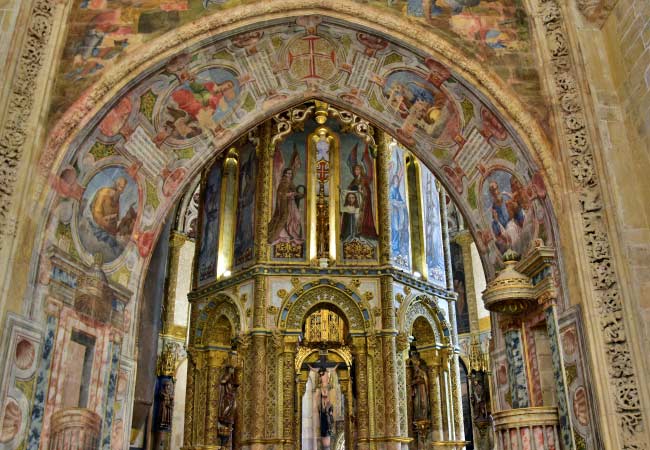
The Charola inside the Convento de Cristo
Suggested 1 day walking tour of Tomar
This walking tour covers all the major attractions of Tomar in a logical route that allows you to experience the town's rich heritage. The entire walk takes about 4-5 hours at a relaxed pace and the green line cover 7km. The tour begins from the train station, which is where most visitors arrive.
Begin your exploration at Tomar's train station (1), a charming building adorned with traditional blue and white azulejo tiles depicting local scenes. This sets the tone for the artistic treasures you'll encounter throughout the day.
From the station, walk straight ahead down Avenida Dr. Cândido Madureira for approximately 600 metres. The tree-lined avenue leads you gently towards the historic centre, with the castle visible on the hill ahead as a constant reminder of your ultimate destination.
Your first proper stop is the delightful Parque do Mouchão (2), an island park in the middle of the Nabão River. This green oasis provides a peaceful introduction to Tomar, with shaded paths perfect for escaping the midday heat. The park's centrepiece is an enormous wooden waterwheel, a reminder of how the river once powered the town's mills and industries.
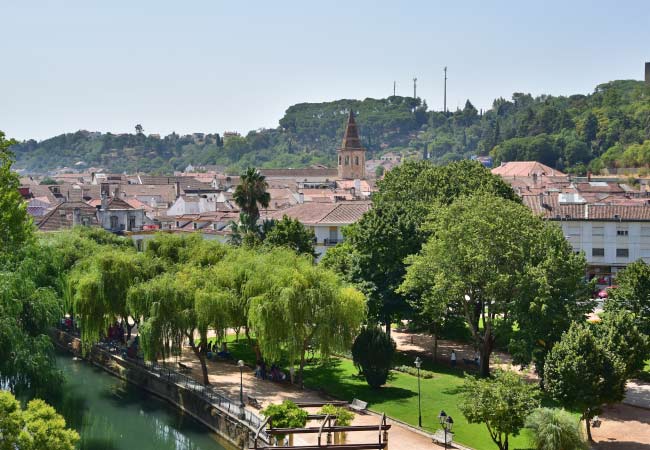
Cross the Ponte Velha (Old Bridge) (3) to enter the historic centre. Despite its name suggesting Roman origins, this stone bridge dates from the medieval period.
Follow Rua Serpa Pinto (4), Tomar's main pedestrian shopping street. Known locally as the "Corredoura", this bustling thoroughfare is lined with traditional shops, cafés and bakeries. Stop at one of the pastelarias to sample Tomar's famous conventual sweets - the Fatias de Tomar (egg yolk pudding) or Beija-me Depressa ("Kiss me Quick" cakes) provide the perfect energy boost for the climb ahead.

Turn into the narrow Rua Dr. Joaquim Jacinto to discover the Sinagoga de Tomar (5). This unassuming building houses one of only two pre-expulsion synagogues preserved in Portugal. Built between 1430 and 1460, its interior features four columns representing the matriarchs of Israel and remarkable acoustics created by clay jars embedded in the ceiling. The small museum tells the poignant story of Tomar's Jewish community, which thrived here until the forced conversions of 1496.
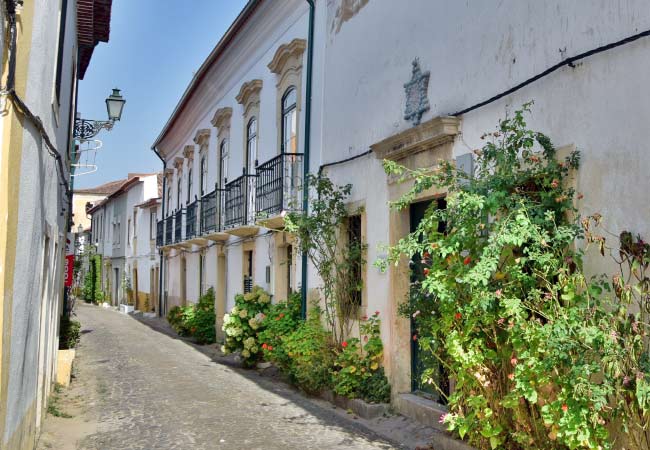
Continue to the Praça da República (6), Tomar's magnificent main square. The distinctive black and white calçada Portuguesa pavement radiates from the central statue of Gualdim Pais, the Templar Grand Master who founded Tomar in 1160. Take time to admire the square's harmonious architecture, including the 17th-century Câmara Municipal (Town Hall) (8) with its elegant arcade.
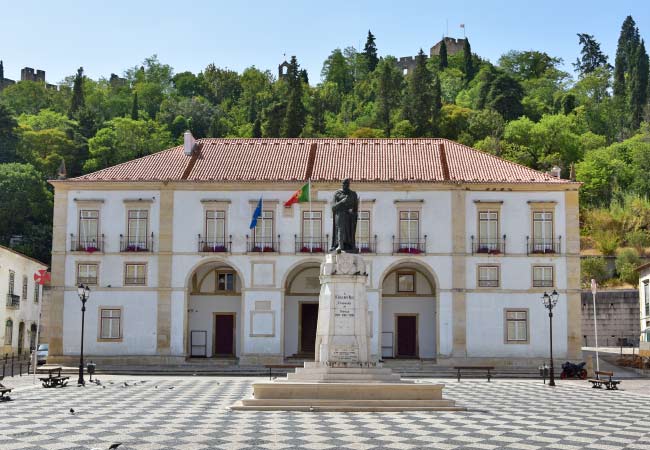
On the western side of the square stands the Igreja de São João Baptista (7). This 15th-century church showcases a flamboyant Gothic portal and an octagonal bell tower with a 16th-century clock that still keeps time for the town. Inside, look for the six remarkable panels by Renaissance artist Gregório Lopes and the intricately carved stone pulpit.
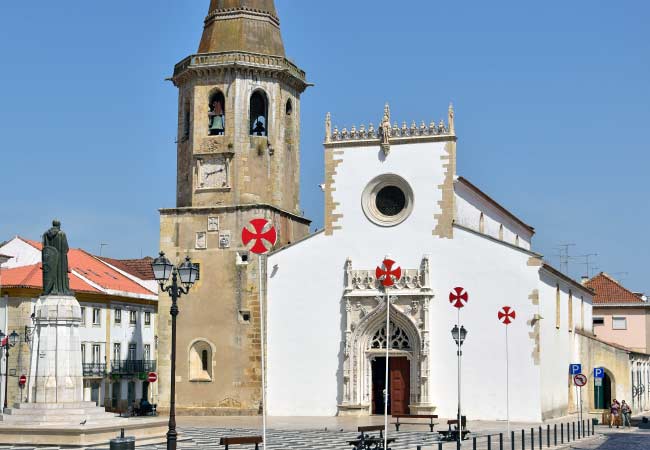
From the Praça da República, the impressive castle is clearly visible above you. The most direct route is the Calçada de São Tiago, a steep but rewarding cobbled path that begins near the town hall. The 10-minute climb takes you directly up the hill to the castle or the main entrance (which is on the eastern side of the complex).
The Castelo de Tomar (9) is massive 12th-century walls and crenellated battlements demonstrate the Templars' military might. These fortifications successfully withstood a Moorish siege in 1190, cementing the castle's reputation as impregnable. Walk along the ramparts for spectacular views before entering the Convento de Cristo (10) complex (entrance fee €15).
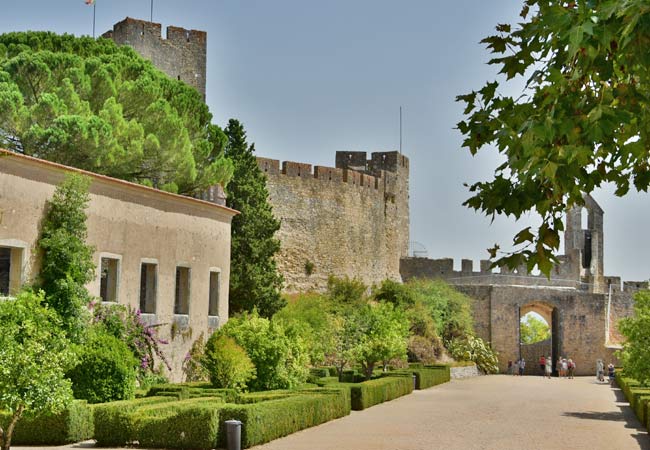
Inside the Convento de Cristo, prepare to spend at least 2 hours exploring this UNESCO World Heritage Site. The complex tells the story of eight centuries through its architecture, from the austere Templar fortress to the ornate Manueline monastery. A full guide to the Convento de Cristo can be read here.
The absolute highlight is the Charola (11), the enigmatic round church at the heart of the complex. Built in 1162, this 16-sided rotunda was modelled on Jerusalem's Church of the Holy Sepulchre. Its unique design allowed mounted knights to attend services without dismounting. The interior dazzles with 16th-century paintings, gilt woodwork and vibrant frescoes added during the reign of Manuel I.
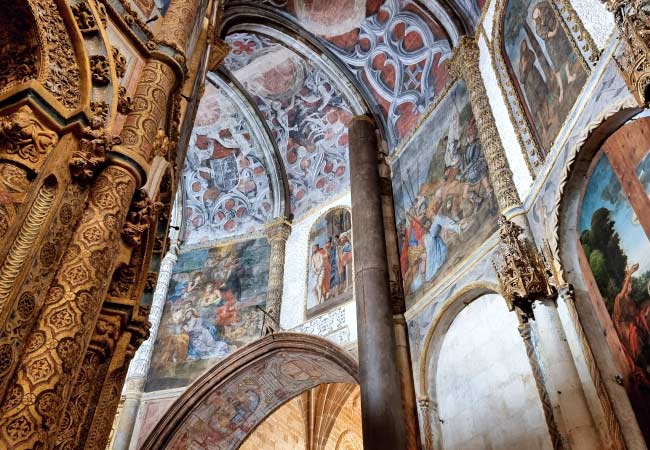
A particular highlight on the western façade is the famous Chapter House Window. This Manueline masterpiece took seven years to complete, its intricate stonework incorporating maritime motifs - ropes, coral, seaweed and armillary spheres - celebrating Portugal's Age of Discovery.
Explore the eight cloisters, each reflecting different architectural periods. The Gothic Cemetery Cloister offers peaceful contemplation, while the Renaissance Main Cloister impresses with mathematical precision and elegant spiral staircases at each corner.
After finishing in convent complex, a worthy detour before heading back into the centre of Tomar is the Igreja de Nossa Senhora da Conceição (12). This small chapel, a gem of pure Renaissance architecture from the 1530s, rewards visitors the wonderful panoramic views over Tomar from the terrace outside.
Depending on time you may wish to take a relaxing stroll through the Mata Nacional dos Sete Montes (13). This 39-hectare forest park, was once the convent's private garden. Its shaded paths are perfect for a peaceful walk, allowing you to appreciate the scale of the convent's former estate. Along the way, you might spot the "Charolinha", a small romantic-era temple hidden among the trees.
Next is the Igreja de Santa Maria dos Olivais (14), a 10-minute walk from the centre. This 13th-century Gothic church served as the Templars' pantheon, housing the tombs of several Grand Masters including Gualdim Pais himself. Its unusual free-standing bell tower was known as the "Templars' Lighthouse", guiding travellers to the city.
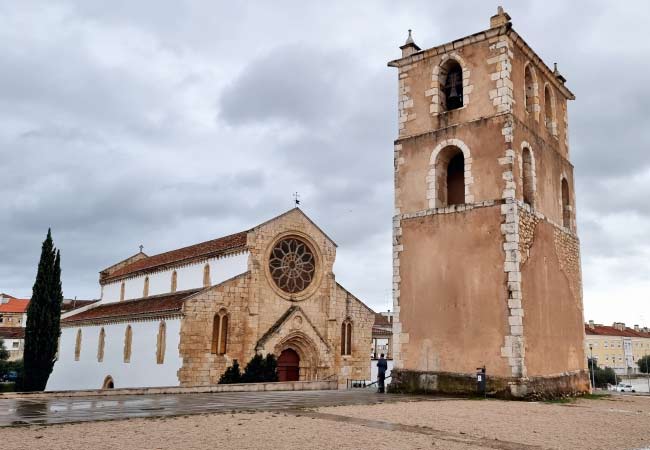
Conclude your tour of Tomar at the quirky Museu dos Fósforos (15). Housed in the former Convent of São Francisco, this unique museum displays over 43,000 matchboxes from 127 countries - a colourful journey through 20th-century graphic design and social history.
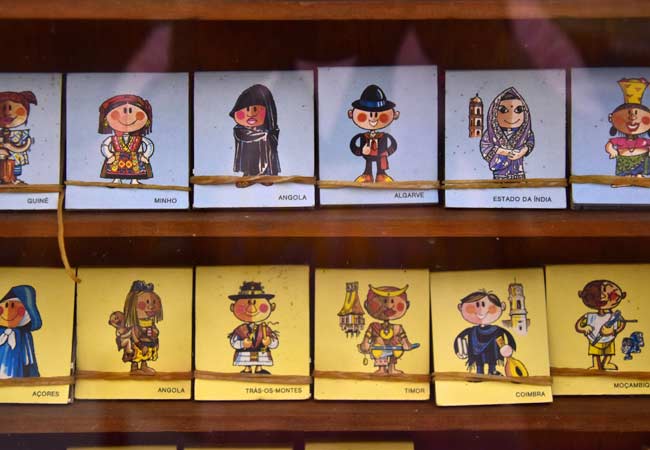
The Igreja de São Francisco (16) is a classic 17th-century church whose simple façade hides a surprising interior of carved and gilded woodwork, which you can see before or after visiting the museum's collection
For those with a vehicle, the area surrounding Tomar offers two remarkable final stops that demonstrate the scale of Templar ambition, from civic engineering to military might.
Pegões Aqueduct (17) - A short drive from the Convento de Cristo brings you to the magnificent 16th-century Pegões Aqueduct. A visit here is essential to appreciate the sheer scale of ingenuity required to support the convent complex. This monumental structure stretches for over six kilometres, an incredible feat of engineering designed to provide a steady water supply.
Castelo de Almourol (18) - For a dramatic conclusion to your Templar-themed day, consider the nearby Castelo de Almourol. Positioned scenically on a small, rocky island in the middle of the Tagus River, this is one of Portugal’s most iconic castles. Rebuilt by Gualdim Pais, the same Grand Master who founded Tomar, it is a fortress that feels as if it has been taken straight from a legend.
Discover more of central Portugal with our guides
If you've found our content valuable, we'd welcome your support.
The digital publishing landscape has evolved significantly. As a small independent publisher, we face growing challenges. Search engines increasingly favour paid content over organic results, while AI-generated content often reproduces original work without attribution.
To support our work, please consider bookmarking this page (press Ctrl + D) for quick access. If you find an article helpful, we'd be grateful if you'd share it with friends on social media.
For specific questions, please see our Reddit community at r/LisbonPortugalTravel.
Should you notice any outdated or incorrect information, please contact us at [email protected]
Thank you for helping us continue to provide valuable content in an increasingly challenging digital environment.





















